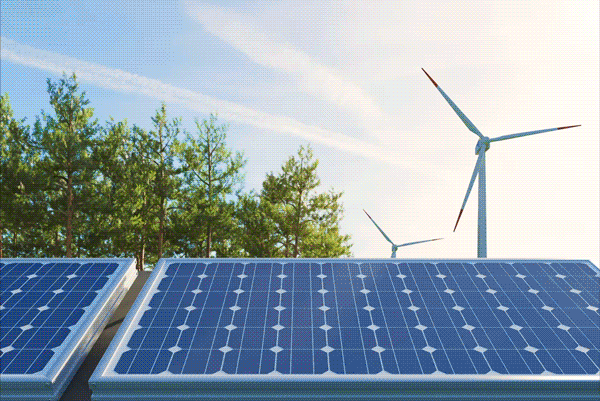
What is CO₂ and why is it essential to reduce its emissions?
At some point have you wondered why CO₂ is so important in climate change talks? Although we don't see it or smell it, this invisible gas is one of the main culprits responsible for keeping heat in our atmosphere, acting as a 'coat' for the Earth. This would be a good thing if it weren't for the fact that, over the past few decades, we have filled that 'extra layers' with our activities, such as the use of fossil fuels. The result? An ever-warming planet. Today, understanding the impact of CO₂ and finding sustainable ways to reduce it are key steps toward a healthier future for all.
What is CO₂ or carbon dioxide?
Carbon dioxide, or CO₂, is a key greenhouse gas that retains heat in the atmosphere. It comes from both the extraction and burning of fossil fuels, such as coal, oil and natural gas, and from forest fires and natural processes, such as volcanic eruptions. It is a gas that we cannot see or smell, but it plays a fundamental role in the Earth's atmosphere, being one of the main gases responsible for global warming and climate change. In addition to CO₂, there are other gases, such as methane and nitrous oxide, which also trap heat in the atmosphere. These gases are called greenhouse gases (GHG) and are responsible for increasing the temperature of the planet.
This is a term we have known for centuries, but it was in the late 19th century that scientists began to understand its direct relationship to climate, especially its ability to trap heat in the atmosphere. During the 20th century, it began to be noticed that the burning of fossil fuels was drastically increasing CO₂ levels, which in turn was contributing to global warming.
It was not until the 1970s and 1980s that the impact of CO₂ began to be a serious concern, and the international community began to take action. Since then, agreements such as the Kyoto Protocol and the Paris Agreement have been promoted, seeking to reduce greenhouse gas emissions. Today, awareness of this issue is much greater, and we are seeing more actions to control CO2, from clean energy to sustainable practices such as the circular economy.
Main activities that emit CO2

How does CO₂ affect health?
Carbon dioxide not only affects the climate, but also has repercussions on our health, although not always directly. Although CO₂ itself is not toxic in normal concentrations, its accumulation in the atmosphere triggers a series of side effects that can affect people's well-being.
- Air quality: Although CO₂ is not considered a pollutant hazardous to health per se, its increase contributes to the creation of other pollutants, such as tropospheric ozone. This ozone, which forms near the ground, is an irritant that directly affects the quality of the air we breathe. Poor air quality can trigger respiratory problems in vulnerable people, such as children, the elderly or those with conditions such as asthma.
- Respiratory problems: Prolonged exposure to pollution related to CO₂ emissions can worsen pre-existing respiratory conditions, such as asthma and lung disease. In places where fossil fuel burning is high, levels of particulate pollutants also increase, which can irritate the airways and affect lung function in people, even those without previous problems.
- Extreme weather phenomena: Global warming caused by increased CO₂ in the atmosphere is associated with more extreme and frequent weather phenomena. This includes more intense heat waves, which can lead to heat stroke and dehydration, especially in the most vulnerable populations. In addition, events such as floods or hurricanes also affect health, not only directly, but also by increasing the spread of diseases related to the lack of access to drinking water or the proliferation of vectors such as mosquitoes.
- Food security and nutrition: Increased CO₂ in the atmosphere also affects agricultural production, as climate change impacts rainfall patterns and temperatures, critical factors for crop growth. This can lead to a decrease in food availability and reduced nutritional value, especially in vulnerable countries. Food shortages and poor nutrition impact overall health, increasing the risks of malnutrition, especially in children and the elderly.
How to reduce CO₂ emissions.
Reducing carbon dioxide emissions is a global challenge, but it is also something we can address with concrete actions at both the individual and collective levels. There are several strategies within reach to mitigate the impact of our daily activities on the environment. Here is a simple explanation of how we can achieve this:
- Renewable energies: One of the most effective ways to reduce CO₂ is to leave fossil fuels behind and opt for clean energy sources, such as solar, wind or hydro. These energies do not emit CO₂ when generating electricity, making them a much friendlier alternative for the planet. Many countries and companies are already moving in this direction, but we can also contribute on a personal level by installing solar panels at home or choosing renewable energy suppliers.
- Sustainable transportation: Transportation is one of the main sources of CO₂ emissions. Changing our mobility habits can make a big difference. Using public transport, opting for electric or hybrid vehicles, and, where possible, cycling or walking, are practical ways to reduce our carbon footprint. Even carpooling with others instead of using cars individually helps to reduce emissions.
- Energy efficiency: Improving energy efficiency means doing more with less. This can be applied both at home and in industry. From using energy-efficient appliances to optimizing lighting with LED bulbs, every small adjustment reduces energy consumption and thus CO₂ emissions. Proper insulation in buildings is also essential, allowing comfortable temperatures to be maintained without the need to spend as much energy on heating or air conditioning.
- Reforestation: Trees are our natural allies in combating climate change. climate changebecause they absorb CO₂ as they grow. Reforestation reforestation and forest conservation are key to maintaining the carbon balance in the atmosphere. Planting trees not only helps capture CO₂, but also has additional benefits such as improving biodiversity and protecting the soil.
- Responsible consumption and waste reduction: Opting for products with less packaging, buying locally, and prioritizing reusable or recyclable products are effective ways to reduce CO₂ emissions. The manufacture and transportation of goods consumes energy and resources, so every time we reduce our consumption or reuse a product, we decrease our carbon footprint. In addition, recycling materials such as plastic, paper and glass helps reduce the demand for the production of new materials, which also reduces emissions.
The impact of the circular economy on CO₂ reduction.
The circular economy has gained prominence as one of the most effective solutions to reduce carbon dioxide emissions. While the traditional economic model, known as the linear economy, is based on extracting resources, manufacturing products and discarding them at the end of their life cycle, the circular economy proposes something different: giving products more than one life. This approach not only reduces the use of resources, but also significantly reduces the CO₂ emissions associated with the production and disposal of goods.
- Waste reduction: One of the main benefits of the circular economy is that it reduces the amount of waste that ends up in landfills or is incinerated. When products are reused or recycled, we avoid the need to burn waste, a process that releases large amounts of CO₂ and other greenhouse gases. For example, by opting for recycled products, we are preventing those materials from ending up being discarded and at the same time reducing the demand for new resources.
- More efficient production: Making products from recycled or reused materials requires much less energy than producing them from scratch. This energy saving is key, as most global energy still comes from CO₂ emitting sources such as fossil fuels. For example, recycling aluminum consumes up to 95% less energy than producing it from the original raw material. In this way, recycling not only avoids the accumulation of waste, but also reduces energy consumption and thus emissions.
- Efficient use of resources: In a circular economy, the idea is to maximize the use of products throughout their useful life, which reduces the need to constantly extract new resources. This has a direct impact on CO₂ reduction, as the extraction, transportation and transformation of raw materials is one of the most carbon-intensive activities. By repairing, reusing or recycling products, the demand for new materials is reduced and the environmental impact of extracting and processing them is avoided.
- Promoting sustainability: The circular economy focuses not only on recycling, but on rethinking the entire life cycle of products to make them more sustainable from the start. Designing products that last longer, are easily repairable or can be broken down into recyclable materials is part of this approach. This contributes to a more sustainable, resource-efficient economic system that more effectively combats climate change in the long term.

Conclusion on CO2 reduction
Carbon dioxide reminds us that our daily actions have a real impact on the planet, but also that we have the power to make a difference. From opting for clean energy to rethinking how we consume, there are many ways to reduce our footprint. What resonates most is the circular economy, which goes beyond harm reduction: it invites us to make better use of resources and give more value to what we already have.
It is not just a matter of slowing down the problem, but of living more consciously and responsibly, joining efforts towards a more balanced future. It is time for each of us to become aware and start making those small changes that, together, can make a difference. The future depends on our actions today.




